DOI:10.32604/csse.2023.025449

| Computer Systems Science & Engineering DOI:10.32604/csse.2023.025449 |  |
| Article |
Improved-Equalized Cluster Head Election Routing Protocol for Wireless Sensor Networks
1Department of Computer Science, Institute of Southern Punjab, Multan, 5932, Pakistan
2College of Computer Science and Information Systems, Najran University, Najran, 61441, Saudi Arabia
3Department of Computer Skills, Deanship of Preparatory Year, Najran University, Najran, 61441, Saudi Arabia
4Department of Engineering, National University of Modern Languages, Islamabad, 44000, Pakistan
*Corresponding Author: Ali Alqahtani. Email: eng.alisaeed505@gmail.com
Received: 24 November 2021; Accepted: 10 January 2022
Abstract: Throughout the use of the small battery-operated sensor nodes encourage us to develop an energy-efficient routing protocol for wireless sensor networks (WSNs). The development of an energy-efficient routing protocol is a mainly adopted technique to enhance the lifetime of WSN. Many routing protocols are available, but the issue is still alive. Clustering is one of the most important techniques in the existing routing protocols. In the clustering-based model, the important thing is the selection of the cluster heads. In this paper, we have proposed a scheme that uses the bubble sort algorithm for cluster head selection by considering the remaining energy and the distance of the nodes in each cluster. Initially, the bubble sort algorithm chose the two nodes with the maximum remaining energy in the cluster and chose a cluster head with a small distance. The proposed scheme performs hierarchal routing and direct routing with some energy thresholds. The simulation will be performed in MATLAB to justify its performance and results and compared with the ECHERP model to justify its performance. Moreover, the simulations will be performed in two scenarios, gateway-based and without gateway to achieve more energy-efficient results.
Keywords: Bubble sort algorithm; gateway; energy thresholds; wireless sensor networks
Due to sensor technology and research advancement, a huge trend is developed towards wireless sensor applications and appliances [1]. Smart devices for monitoring purposes are taking the great intentions of the people. Sensors are small electromechanical devices that can sense, store, communicate, and energy resources. Kandris et al. [2], discuss the sensor nodes based on two types of networks: data acquisition for sensing and data distribution for communication. In WSN, the sensor nodes sense the facts and transfer them to the other base station. The base station receives the data and processes it to produce useful information for decision-making. Othman et al. [3] discuss the scattered sensors to monitor environments in various life areas, such as farming, agriculture, health, military, industries, etc. WSN is more practiced for agriculture precisions, animal monitoring, health monitoring, monitoring the military’s border situations, observing labour and fire detection in industries and home automation etc.
Rault et al. [4], write on the significant advancement that comes in the development of wireless sensor networks in recent times. As it has lots of advantages, it contains some drawbacks also. Because WSN is based on small sensor devices with limited energy resources, it isn’t easy to apply for large and long-time monitoring purposes. Many researchers make efforts to increase a network’s lifetime via better routing techniques to obtain a high quality of services by the researcher to meet the energy issue of WSN. For this purpose, many routing protocols are designed to meet the energy efficiency of wireless sensor networks.
In most routing protocols, clusters are made to enhance the lifetime of the networks. All of these clusters must appoint their heads, then node data is transferred to the cluster heads, and the cluster head is further sent to the base stations. The communication among nodes and base stations can be directly, and intermediate cluster heads to the base station. In the I-ECHERP routing scheme, the node was divided into these clusters. These clusters also choose their head using a bubble sort algorithm based on nodes remaining energy and the distance to the next hope. A linear equation system is used to store the current energy and the location of a node, which is used to choose the cluster head. However, some energy boundary has also been used to distribute the energy load among nodes to ensure all nodes remain active throughout the whole process. The gateway is also used to get high-value outcomes of this proposed model.
The rest of the paper is organized as follows: Section 2 contains the energy-efficient routing protocol for wireless sensor networks. In Section 3, the proposed model includes the details about the proposed routing protocol. In Section 4, the performance of the proposed model is analyzed in detail. In the last Section 5, the conclusion is drawn along with the future work of this proposed routing protocol for WSN.
Many studies exist in the deployment of routing protocols for wireless sensor networks. Mainly applications were considered for the development of such protocols and their architecture. One of the most important is energy efficiency because energy-efficient routing is very significant for expanding network lifetime.
Heinzelman et al. [5], proposed a low-energy adaptive clustering hierarchy known as LEACH, based on random clustering. The cluster head rotates randomly to distribute the energy load to enhance the network’s lifetime even though the nodes of the system also deal with energy distribution. Leach applies data fusions to reduce the data, save energy, and exercise local coordination to enable scalability and robustness for the network. This model works in a two-phase setup and a steady-state phase. In this setup, round clustering was performed, and the head was appointed. In the steady-state phase, data is transmitted to BS. Leach uses single hope routing and transfers information directly to the base station that is not practiced for large areas. Qureshi et al. [6], develop a routing protocol is based on the balanced energy-efficient network-integrated super heterogeneous network that divides the nodes into four energy levels. In BEENISH, the cluster leader is selected by the residual energy to reduce the energy expenditure and prolong the network life span.
Lindsey et al. [7], design a leach base scheme that chooses the next hope for data transfer. Node’s data is sent to its closest neighbor to save energy by avoiding choosing the next hope at a large distance. This mechanism route the data to transfer as a chain from the node through intermediate nodes to sink is known as PEGASIS. Javaid et al. [8], proposed a distributed energy-efficient clustering model to overcome the energy issues. This technique is based on the dynamic changes in the probability of the cluster head selection. The simulation justified it’s performance in the context of energy efficiency and the network lifetime. Murugantathan et al. [9], propose a base station control dynamic routing scheme identified as BCDCP that works based on energy load distribution among nodes to enlarge the network’s lifetime. Initially, all nodes that are part of the system have similar power capacity and transmission and storage ability as well as the base station remains unchanged throughout the whole process. This scheme uses the data fusion technique to reduce the data and save energy to minimize energy consumption. For this purpose, the BCDCP model uses stationary nodes to ensure energy competency. Qing et al. [10], design a distributed energy-efficient clustering-based scheme acknowledge as DEEC that appoints the cluster leader based on probability among node residuals and average energy. The epoch for being cluster chief varies as per initial and residual energy. In this scheme, nodes with more opportunity to be the cluster head have maximum initial and residual power. This scheme’s results are better in the simulation than previous ones in the end. Aallirani et al. [11], propose a model that forms in the cluster based on low latency recognize as EECFP. High energy nodes appoint as cluster heads, and they rotate for energy load balancing. In this method, energy consumption decreases, and the network’s lifetime will increase.
Nikolidakos et al. [12], proposed ECHERP as an energy-efficient routing model based on equal clusters. Sensor nodes randomly scatter in the network region and are grouped into clusters. This routing scheme’s basis on the idea LEACH model; however, it has a new way to choose the cluster head. The Gaussian elimination algorithm selects the cluster head for each cluster by considering the node’s residual energy. This model divides the nodes into fifty clusters, and a few of them are near the base station considered high-level clusters, and those located away from the base station are known as low-level clusters. Nodes sense data and send it to their appropriate head; the Low-level cluster head sends their data to the upper-level cluster heads until it reaches the base station. Cluster heads use the hierarchal routing scheme for communication. Zaman et al. [13], develop a position responsive routing protocol (PRRP) that uses flat, hierarchical, and spot-based routing procedures for energy efficiency. Nodes in this model are organized into four quads, and each quad has two clusters, which consider the left-over energy and distance to appoint the head of the cluster. Jose et al. [14], a mobile sink assisted uses the mobile sink assistance to meet those issues that occurred in the previous models. It is a cluster-based hierarchal routing mechanism to obtain enhanced results in the end. Naranjo et al. [15], propose a routing protocol a Prolong stabled election routing protocol identified as PSEP; it is based on dynamic clustering to achieve high efficacy results by dealing with nodes as normal and advanced nodes. However, each node part of the cluster can become the cluster’s head, but the advanced nodes are exhorted to be cluster heads for better results.
Khan et al. [16], proposed an energy-efficient multistage routing protocol familiar as EEMRP facilitates data transmitter nodes with recharging and network divided into three regions: S1, S2, and S3. The S2 nodes consider as non-clustered regions; however, cluster regions send data to a non-cluster to further covey to the base station. Venkataramana et al. [17], develop an energy-saving and time-reducing routing protocol mainly concerned with time and energy issues of WSN and based on homogeneous and heterogeneous networks. Nodes divide into four modules in this routing model to achieve energy efficiency. A dominant node is used for data communication. Definite relations are designed to cause typical or prevalent devices at election stages to ensure working as per the proposed model. Xiu-wu et al. [18], propose a dynamic clustering-based wolf pack algorithm for routing protocol is acknowledged as CLWPA with fixed location nodes with a similar initial energy-based protocol. This scheme is used for the first-order radio energy model to estimate energy consumption. Selection of Cluster heads from the ordinary nodes to transmit data to the base station to join the issues of WSN associated with energy efficiency. Sajwan et al. [19], propose a flat & hierarchal routing scheme used to make cluster and cluster heads boost up the energy efficiency of WSN. Nodes in the cluster perform the multi-hope routing, and data is broad-casted to the cluster heads from the normal nodes; the CH transmits the data to the recomputed path to sink. The maximum residual energy is selected as the next hope selfishly for data communication in the routing protocol.
Gbadouissa et al. [20], design a routing protocol that proposes heuristic clustering using the hypergraph theories that achieve the network’s energy efficiency. This theory takes low energy in the clustering phase and cluster head selection phase. This routing scheme called hypergraph theory clustering its simulations justified the performance. Vasan et al. [21], designed a clustering scheme to collect the cluster head data using the mobile agent. This routing protocol is called the mobile agent-based improved implemented protocol for mobile agencies. An improvement over the existing scheme I-LEACH. Jia et al. [22], propose an un-equal multi-hope clustering algorithm for wireless sensor networks. This protocol selects the cluster head based on residual energy. The sensor node with more nodes around can become a cluster head. All of the above-mentioned routing protocols used various algorithms for getting energy-efficient routii it produces better fallouts by choosing the cluster head based on nodes’ residual or average energy. With all of the possible scenarios, some issues with the proposed model remain behind. That’s why we proposed a new model by considering a few possibilities for improvements in the ECHERP model to enhance the results in the contest of the energy efficiency of WSN.
This section will discuss the proposed model name Improved ECHEPR based on the bubble sort algorithm used to choose the cluster leader using the residual energy and the distance of nodes. The nodes organize in the bubble sort algorithm for nodes data in each cluster stored in the system of linear equations. The proposed model uses the bubble sort algorithm that considers the nodes’ location and their remaining energy of SN’s to choose the CH. The proposed algorithms initially select the first two nodes, with maximum energy in each cluster; after that, the distance of these two nodes is estimated with the next hope, and the short distance node appoints as the head of the appropriate cluster for the current round. Here is the description of the newly designed model named I-ECHERP.
The energy model is adopted in our proposed model, similar to in LEACH or ECHERP model. Each node that used the energy for data transmission identifies as Etx(k, d); where k indicates the data container size. The d indicates the distance from the sender to the receiver node. The transmitter circuitry shows Etx-elec (k) & the transmitter amplifier is indicated as Etx-amp(k, d). Determining the energy dispatched by a node to transfer data to another node is calculated with this equation.
Moreover, a node that received the data uses energy also. The following equations will use to estimate the power that utilizes to receive data. In the stated equation, the Erx-elec indicates the energy used to receive the data, and K represents the size of a received data packet size.
Tab. 1 presents the parametric values to specify the proposed routing model—simulations based on parameters.

The proposed scheme consists of sensor nodes and the Gateway, BS. Gateway and base station have limitless energy resources; however, the nodes are energy constraints. More energy is consumed if the base station is at a long distance from the network, and more energy will be used for data communication. Clustering performs for the scattered nodes based on their distance to the base station. Each cluster must appoint its new head at each round to distribute the energy spending load between all nodes. The clusters consider the level based on their distance to the base station as low and high-level clusters. The low-level cluster head uses the upper level to transfer data to the base station via a gateway or without a gateway by practicing the hierarchal routing technique. Moreover, some energy thresholds were used at upper-level nodes to ensure balanced energy consumption.
One of the critical factors of this protocol is the authorization of the cluster head. To choose the cluster head bubble sort algorithm is used, which considers the nodes’ remaining energy and the distance to select the cluster head at each round. The more efficient cluster head selection mechanism will help achieve more energy efficiency and enhanced network lifetime. Gateway also saved energy dispatch during communication at a large distance between nodes and the base station.
3.3 Major Contributions in I-ECHERP
The main contribution of the proposed model is the use of the bubble sort algorithm that is more efficient in the scenario of the time complexity used in the baseline paper. Moreover, the cluster head selection method and the use of hierarchical routing schemes along with some energy thresholds to enhance the network lifetime. Also, the use of the gateways gets long lifetime network for wireless sensor networks. All of these adopted techniques are more useful for the network energy utilization Simulation will show better performance of the proposed routing protocols.
3.4 The I-ECHERP Network Model
Fig. 1 shows the adopted network model based on sensor nodes clusters and the cluster heads, gateway, and the base station. According to Fig. 1, sensor nodes send their data to the cluster heads, and each cluster head further sends it to its next level cluster head until it reaches the base station through the gateway. Further, we will discuss the step-by-step process of the proposed model.
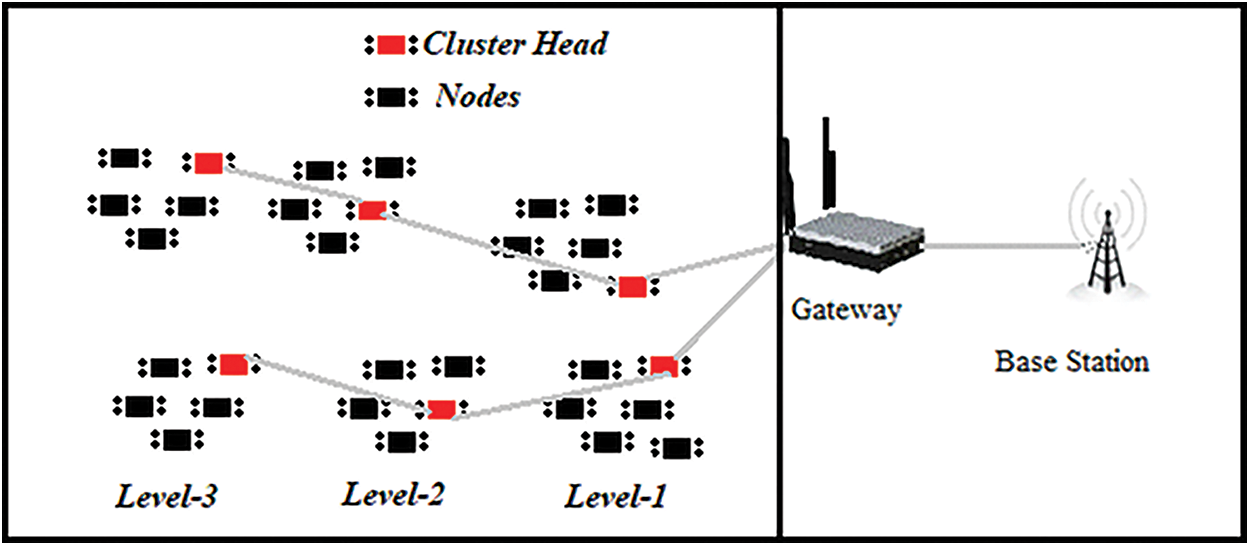
Figure 1: The network model adopted
The step-by-step process of IECEHRP routing protocol for WSN is as follows.
• The base station TDMA schedule and ask all the nodes to advertise them. Nodes send their energy situation and location in reply to the base station. In this way, BS has global knowledge about the network, and each node is assigned a unique identity.
• All nodes divide into clusters based on their distance to the base station.
• The base station selects the cluster head using the bubble sort algorithm to enhance the network’s lifetime.
• Nodes send their sensed data to the CH. The cluster head aggregates received data from nodes in a specific cluster and further sends it to the upper-level cluster head, identifying as an intermediate node toward the base station.
• In each round, total sensed data from the field are transmitted to the base station from nodes to cluster heads via intermediate nodes to the base station via a gateway.
• The net round will start again. The process starts from the cluster head selection using the node’s energy and distance with a Bubble sort algorithm.
• This process will continue until the expiration of the last node in the network.
3.5 Flow Chart of I-ECHERP Model
The flow chart of the proposed routing protocol is as follows.
Fig. 2 shows the flow chart of the proposed model to describe the whole process of routing for a wireless sensor network.

Figure 2: The flow chart of the proposed model
The pseudo-code for the proposed cluster head selection bubble sort algorithm:
Fig. 3 shows the bubble sort algorithm used to select the cluster head in the proposed model. The proposed model performs cluster only once to avoid energy consumption for re-clustering. Clustering performs, and nodes organize in linear equations as per their current location and the energy situation. The bubble sort algorithm is implemented to choose the cluster leaders at each round by considering the energy situations and communication distance. Both of these factors are more useful for a lifetime network.
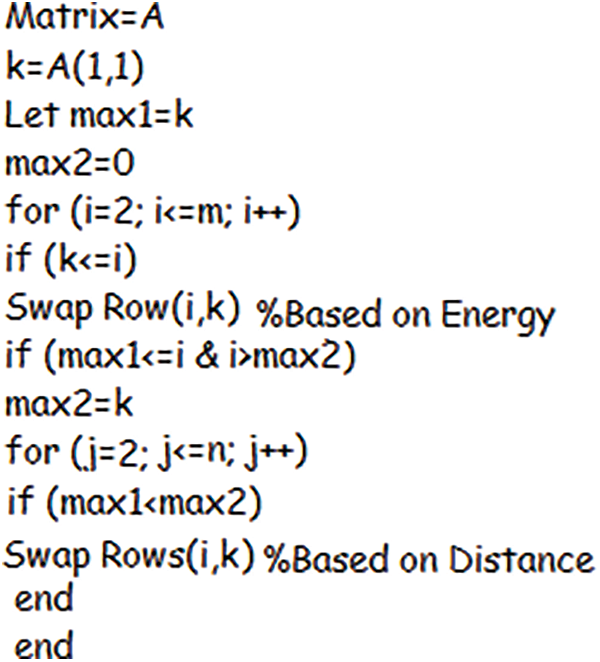
Figure 3: Bubble sort algorithm
The bubble sort algorithm works in two phases. In the first phase, algorithm execution chooses two nodes heaving maximum energy level. In the second phase, both compare based on their distance to the next hope short distance node eliminated as cluster head. The first-order energy model is used to calculate the energy consumed to send the data. In each round, the energy situation changes as the node uses it to send data to the cluster head, and the cluster head uses to send to the intermediate cluster head or base station.
In our proposed model, the nodes within the cluster organize into a system of linear equations. As we have K numbers of nodes in the cluster, the A matrix will represent the nodes’ energy level, and the X indicates the node’s location as X-axis, and Y indicates the Y-axis location of the node. By using the bubble sort algorithm, it will use to obtain a cluster head as per the stated mechanism. Here as shown in the A, X & Y matrix, they indicate the node’s information. They represent as in the given equation shown in Fig. 4.

Figure 4: The matrix used to store the values of each cluster node
4 Performance Evaluation of I-ECHERP
To measure the system’s performance, we have divided five hundred sensor nodes into fifty clusters in the total net area of 100*100 meters. The architecture of the proposed network is considered, as stated here.
• A base station is a fixed location at a distance of 150 meters from the center of the network.
• Sensor nodes initiate with equal energy resources, and the network is homogeneous.
• The node’s location is unknown in advance, and their place changed slightly at every round within the cluster.
• The transmitter adjusts the amplifier energy according to the distance for each transmission.
• The data packet size and the sensing rates remain the same for all nodes in the network.
Othman et al. [3], discuss the WSN deal with tracking and monitoring related applications. For monitoring purposes, it can apply to health, power, inventory location, agriculture, home, factory, wellness, farmhouse, process automation, structural monitoring, etc. Wireless sensor applications develop for animal tracking, objects, and human vehicles in the tracking system. The WSN applications can be used in the health, military, and business, public & industrial sectors to monitor and track various objects.
Our proposed cluster-based hierarchal routing model is more applicable in a real-world application for monitoring purposes like monitoring the buildings of any industry for fire monitoring. The activities of labour can also observe in the factory more effectively. In this case, a cluster develops with the nodes at a building. The head receives the fact and further sends it to the next cluster head of another building until it will reach to the BS. These types of methods are more suitable in the sense of energy-efficient routing, especially for the out proposed scheme.
Simulation performs in Matlab with 500 sensor nodes with initially the same energy level. Gateway locates at a side of the network; however, the base station is at least a 100-meter distance from the network center. The data packet size is 4000 bits, which remain similar throughout the network for all sensor nodes. As stated in the previous section, the first-order radios energy model was used to estimate the energy used to transmit data from nodes to other nodes or BS. The base station and gateway have limitless energy resources heaving the possibility for recharging or replacing. Our assumed sensor node is immobile that sends its data to the base station at each round. However, according to the network structure, low-level nodes use intermediate nodes to convey their sensed data to the base station based on the hierarchical routing technique to distribute energy consumption load among all nodes to develop a lifetime network.
Fig. 5 shows the result of the proposed model IECHERP, and ECHERP to indicate proposed model improvements in the contest of their energy dispatch per round. These routing models have two-joule initial energy; however, IECHERP can send its data to the base station for more rounds than the base research as per simulations. The simulations results for moth schemes are as figured out there.

Figure 5: Average energy dispatch for both I-ECHEPR and ECHERP models
Fig. 6 shows the ECHERP uses the two-joule average energy by sending data to the base station to 145 numbers rounds. In comparison, our proposed scheme works more efficiently and uses dispatch the same amount of average energy in 220 rounds. These stated figures justify our proposed model more effectively.
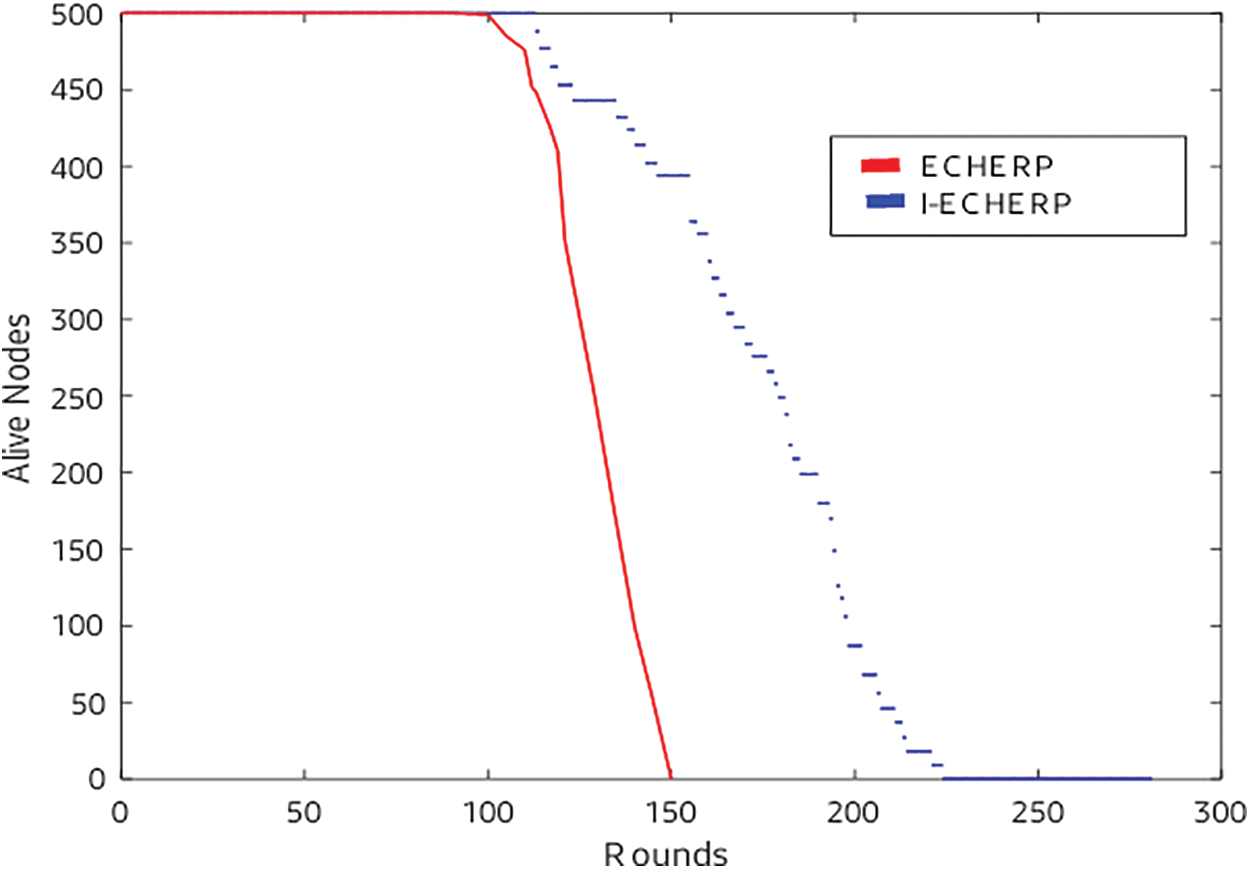
Figure 6: Number of alive nodes for both I-ECHERP and ECHERP models
Fig. 6 shows the results for both model IECHERP, and ECHERP in the context of the numbers of alive nodes in rounds. Here we share the findings of both models, the number of alive nodes vs. the number of rounds.
Fig. 7 shows that the ECHERP send its data to the base station up to 145 numbers of rounds, and its first node is dispatched at 99, however, in the proposed model the first node is dispatched at 115 round and the last node at 220 rounds. The improvements clearly understand that the proposed model performs more effectively than our base study, and it can enhance the lifetime of the wireless sensor network.
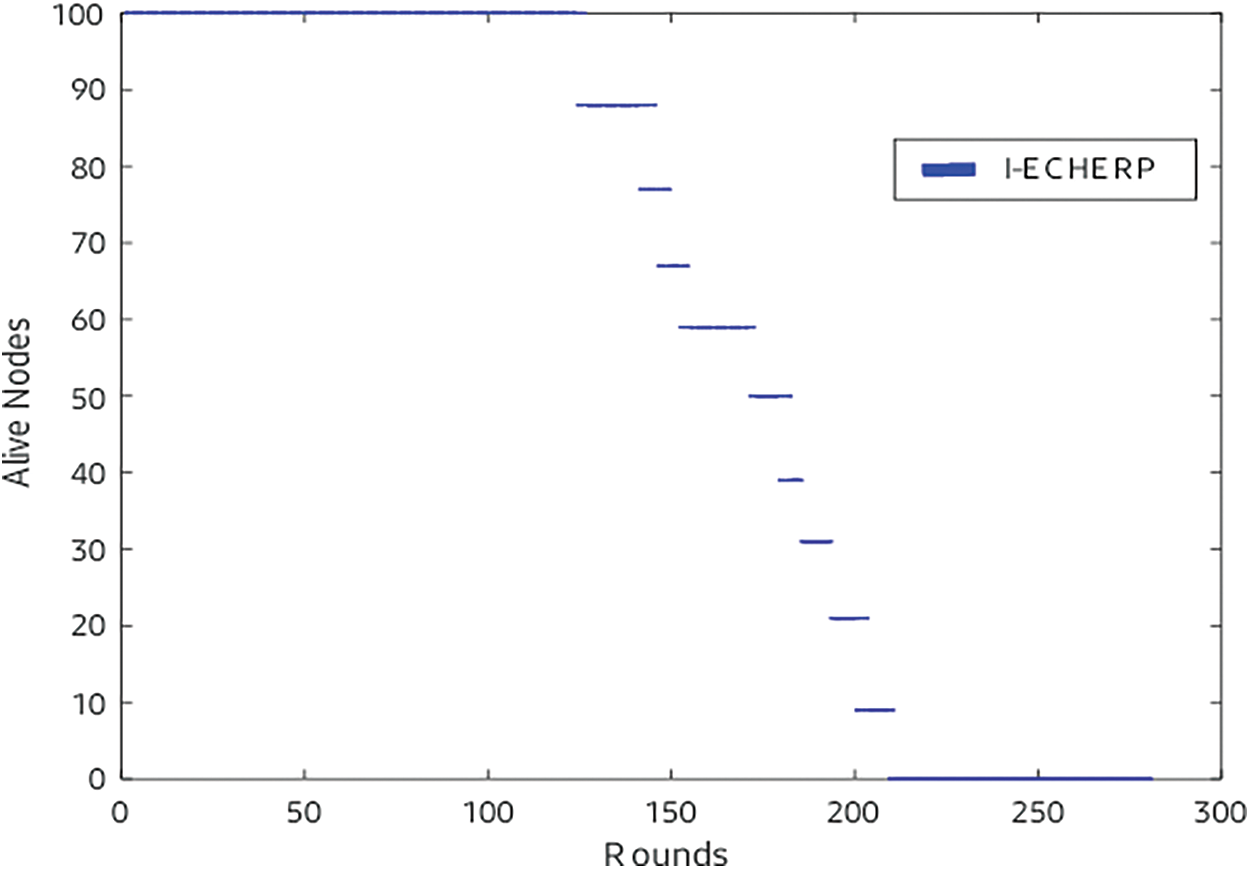
Figure 7: I-ECHEPR models results for alive nodes vs. numbers of rounds
The proposed model simulates by decreasing the numbers of nodes and clusters. The result in Fig. 7; is the alive nodes vs. the average energy consumption with the number of rounds.
Figs. 8 and 9 indicate the simulation results of the I-ECHERP model with 100 nodes with 10 clusters in the same network area in this scenario; the finding is better than the results with 500 nodes with 50 clusters. The average energy dispatch is more efficient with fewer nodes as in the simulation produced.
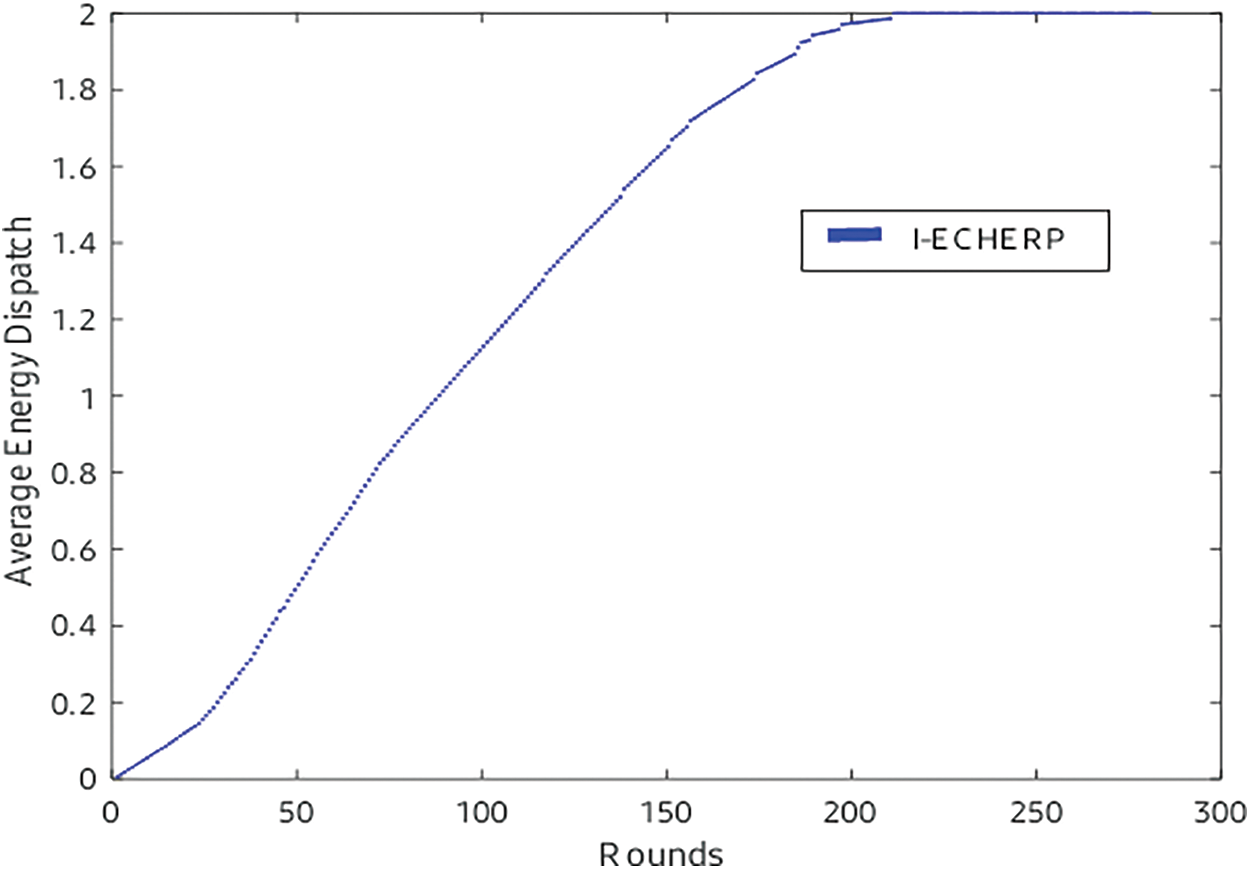
Figure 8: I-ECHEPR models results for average energy dispatch vs. numbers of rounds
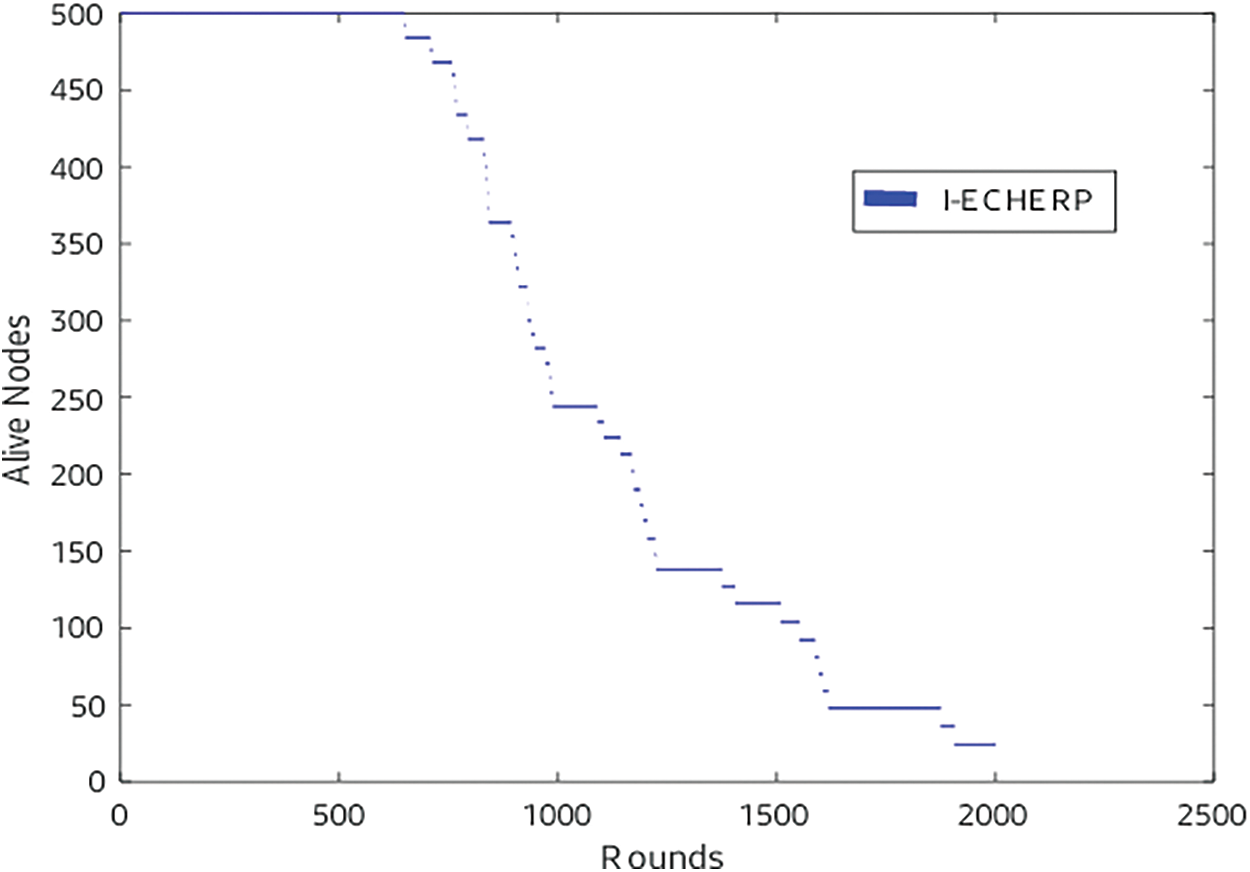
Figure 9: Gateway based scenario results of I-ECHERP model for alive nodes vs. numbers of rounds
Figs. 10 and 11 indicate the results of the I-ECHERP routing protocol for wireless sensor networks in the scenario of gateway-based networks. As we have produced the results in both scenarios with gateway and without gateway here in this image, the findings of the proposed model are shown.

Figure 10: Gateway based scenario results of I-ECHERP model for average energy consumption vs. numbers of rounds
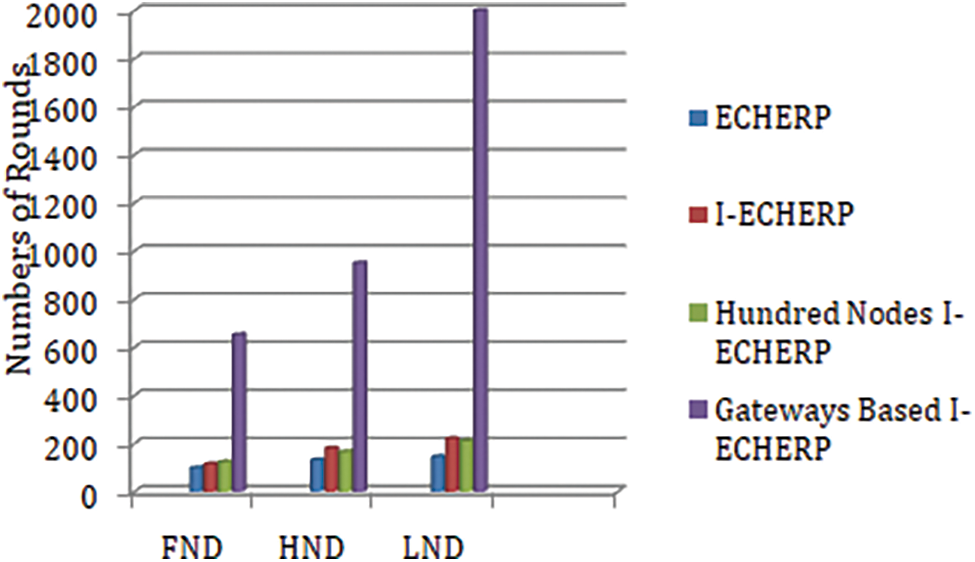
Figure 11: Comparison of results in the scenario first, half, and last node depletion time
In this given Figs. 10 and 11, results of the I-ECHERP energy-efficient routing protocol for wireless sensor networks are presented. By using a gateway with unlimited energy, clearly show the performance of a proposed protocol. The first node depletion round is 652, and it works more than one thousand rounds with an average energy of 2 joules.
The results of the I-ECHERP are shown as the first node depletion (FND), half nodes depletion (HND), and last node depletion (LND) time for the ECHERP and the I-ECHERP model. In the given figure, the results for the I-ECEHRP model show the scenarios of the one hundred sensor nodes-based network and the gateway-based network. All of the findings are shown in the given figure below.
The results of the I-ECHERP routing protocol for wireless sensor networks are given in Tab. 2, along with the base research model ECHERP. This table also contains the results with 100 sensors nodes scenarios as well as the gateway base circumstances.

In this article, the IECHERP routing protocol is presented, which is based on the ECHERP model, with some improvement. The bubble sort algorithm is more efficient in choosing the cluster head on the base of the node’s energy and the distance to select the CH. Some energy thresholds at cluster head level are used with hierarchal routing processes among cluster heads to distribute energy load develop a lifetime network. This proposed scheme produces enhanced results in the simulations compared to the existing model ECHERP. The results with and without gateway are shared in detail.
In the future, this research work can be enhanced by using some aggregation techniques at the cluster head level to minimize the data size to reduce energy consumption. Due to the gateway delay in the data communication in the future, it’s been possible to trim down this delay.
Funding Statement: The author received no specific funding for this study.
Conflicts of Interest: The authors declared that they have no conflicts of interest to report regarding the present study.
1. J. Yick, B. Mukherjee and D. Ghosal, “Wireless sensor network survey,” Computer Networks, vol. 52, no. 12, pp. 2292–2330, 2008. [Google Scholar]
2. D. Kandris, P. Tsioumas, A. Tzes, G. Nikolakopoulos and D. D. Vergados, “Power conservation through energy-efficient routing in wireless sensor networks,” Sensors, vol. 9, no. 9, pp. 7320–7342, 2009. [Google Scholar]
3. M. F. Othman and K. Shazali, “Wireless sensor network application: A study on environment monitoring,” Procedia Engineering, vol. 41, no. 39, pp. 1204–1210, 2012. [Google Scholar]
4. T. Rault, A. Bouabdalllah and Y. Challal, “Energy efficiency in wireless sensor network: Atop down survey,” Computer Networks, vol. 67, no. 7, pp. 104–122, 2014. [Google Scholar]
5. W. R. Heinzelman, A. Chandrakasan and H. Balakrishnan, “Energy-efficient communication protocol for wireless sensor network,” in Proc. of the 33rd Annual Hawaii Int. Conf. on System Sciences, Maui, HI, USA, pp. 1–10, 2000. [Google Scholar]
6. T. N. Qureshi, N. Javaid, A. H. Khan, A. Iqbal, E. Akhter et al., “BEENISH: A balanced energy efficient network integrated super hatrogeneous protocol for WSN,” Procedia Computer Science, vol. 19, no. 111, pp. 920–925, 2013. [Google Scholar]
7. S. Lindsey and C. S. Raghavendra, “PEGASIS: Power efficient gathering in sensor information system,” in Proc. of the 33rd Annual Hawaii Int. Conf. on System Sciences, Big Sky, MT, USA, pp. 3–3, 2002. [Google Scholar]
8. N. Javaid, T. N. Qureshi, A. H. Khan, A. Iqbal, E. Akhter et al., “EDDEEC: Enhanced development of distributed energy efficient clustering for hatrogeneous wireless sensor networks,” Procedia Computer Science, vol. 19, no. 11, pp. 914–919, 2013. [Google Scholar]
9. S. D. Murugantathan, D. C. F. Ma, R. I. Bhasin and A. O. Fapojuwo, “A centralized energy efficient routing protocol for wireless sensor network,” IEEE Communications Magazine, vol. 43, no. 3, pp. S8–S13, 2005. [Google Scholar]
10. L. Qing, Q. Zhu and M. Wang, “Design of a energy efficient clustering algorithm for heterogeneous sensor networks,” Computer Communications, vol. 29, no. 12, pp. 2230–2237, 2006. [Google Scholar]
11. A. Allirani and M. Suganthi, “An energy efficient clustering formation protocol with low latency,” International Journal of Electrical and Computer Engineering, vol. 4, no. 16, pp. 985–991, 2009. [Google Scholar]
12. S. A. Nikolidakis, D. Kandris, D. D. Vergados and C. Douligeris, “Energy efficient routing in wireless sensor networks through balanced clustering,” Algorithms, vol. 6, no. 4, pp. 29–42, 2013. [Google Scholar]
13. N. Zaman, T. J. Low, T. Alghamdi and Turki, “Energy efficient routing protocol for wireless sensor network,” in Proc. ICACT, Pyeongchang, Korea (Southpp. 808–814, 2002. [Google Scholar]
14. D. V. Jose and G. Sadashivappa, “Mobile sink assisted energy efficient routing algorithm for wireless sensor networks,” World of Computer Science & Information Technology Journal, vol. 5, no. 2, pp. 16–22, 2015. [Google Scholar]
15. P. G. V. Naranjo, M. Shojafar, H. Mostafaei, Z. Pooranian and E. Baccarelli, “P-SEP: A prolong stable election routing algorithm for energy-limited heterogeneous fog-supported wireless sensor networks,” The Journal of Supercomputing, vol. 73, no. 2, pp. 733–755, 2017. [Google Scholar]
16. M. K. Khan, M. Shiraz, K. Z. Ghafoor, S. Khan, A. S. Sadiq et al., “EE-MRP: Energy-efficient multistage routing protocol for wireless sensor networks,” Wireless Communications and Mobile Computing, vol. 2018, no. 6839671, pp. 1–13, 2018. [Google Scholar]
17. S. Venkataramana, B. V. D. S. Sekhar, N. Deshai, V. V. S. S. S. Chakravarthy and S. K. Rao. “Efficient time reducing & energy saving routing algorithm for wireless sensor network,” Journal of Physics: Conference Series Int. Conf. on Computer Vision and Machine Learning, Andhra Pradesh, India, vol. 1228, pp. 1–10, 2019. [Google Scholar]
18. Y. U. Xiu-Wu, Y. U. Hao, L. Yong and X. Ren-Rong, “A clustering routing algorithm based on wolf pack algorithm for heterogeneous wireless sensor networks,” Computer Network, vol. 167, no. 2, pp. 106994, 2020. [Google Scholar]
19. M. Sajwan, D. Gosainand and A. K. Sharma, “Hybrid energy efficient multipath routing for wireless sensor networks,” Computers & Electrical Engineering, vol. 67, no. 7, pp. 96–113, 2018. [Google Scholar]
20. J. E. Z. Gbadouissa, A. A. A. Ari, C. Titouna, A. M. Gueroui and O. Thiare, “HGS: Hypergraph based clustering scheme for power aware routing in wireless sensor networks,” Future Generation Computer Systems, vol. 105, no. 9, pp. 175–183, 2020. [Google Scholar]
21. S. Vasan, N. Kalra, R. Kumar and G. Dhiman, “Mobile agent assisted I-leach clustering protocol for IOT applications,” Material Today Proceedings, vol. 257, no. 3, pp. 1–5, 2021. [Google Scholar]
22. Y. Jia, K. Liang and C. Zhang, “An unequal clustering algorithm with load balance for wireless sensor networks,” in Proc. ECAE 2017, Xiamen, China, pp. 160–163, 2017. [Google Scholar]
 | This work is licensed under a Creative Commons Attribution 4.0 International License, which permits unrestricted use, distribution, and reproduction in any medium, provided the original work is properly cited. |